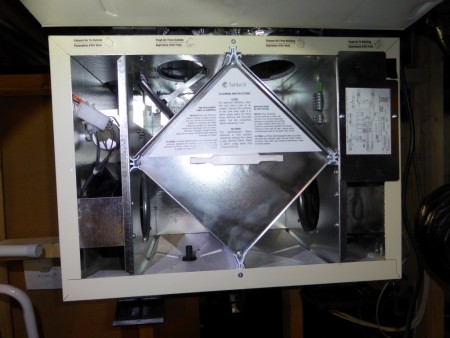As Canada’s most populous province, Ontario will increase the energy performance level of homes by 15% starting in 2017. The new changes are legislated in the province’s updated building code document known as SB-12. The two biggest changes are complimentary; all new homes require heat recovery on ventilation systems and there are incentives for making buildings more air tight as verified by air leakage testing.
Gone are the days of a principal exhaust-only bath fan as a means for ventilating a house. As of 2017 either a Heat Recovery Ventilator (HRV) or Enthalpic/Energy Recovery Ventilators (ERV) are mandatory. Amen! But are home owner’s ready? What about builders, trades and municipal building inspectors?

Kiss the Principal Exhaust fan good-bye! This electrical switch on the main floor would control a “principal [bath] exhaust” fan on the second floor. Most home owners didn’t have the luxury of a labeled switch (as above “FAN SWICH”) and lived blissfully unaware of what the switch was for.

Yes you can still use and install bath exhaust fans, but 2017 will see a whole lot less of these, especially in high performance homes where fully-ducted systems continually exhaust powder rooms, bath and laundry rooms replacing the exhaust fan.
Is Your Tight Home a Cesspool of Mould, Mildew and Rot?
The 1980s launch of Canada’s avant-garde R2000 program for high performance homes never took off. Though tens of thousands of R2000 homes were built, wide-scale adoption never took hold largely due to resistance from the home builders association in the early days.
The standard called for air tight homes with heat recovery ventilators not to mention limited carpeting for better indoor air quality. Some 30 years on, there’s a lot of conjecture about these high performance houses and why they weren’t more popular; and the most damaging, ironic allegation is that they had bad indoor air quality.
Even celebrity renovators like Mike Holms, is on record in Canada’s national newspaper spewing hyperbole like “I remember stories of test homes built so tight, the windows would break if someone slammed the front door. The windows were tiny, and you could literally suffocate in the houses if there was no heat exchanger.” This last sentence shows a persistent conflation of windows and ventilation and this notion needs to be dispelled; windows are for connection to the outside world, day light and fire egress, not for reliable ventilation of conditioned living space. Keeping in mind that all these homes had HRVs in them, Holmes egregiously adds “What they didn’t realize then was that tight houses were also prone to rot. If homes don’t let in some air, they also don’t let moisture out, and that moisture gets inside the walls and eats away at the structure. Your nice, tight home becomes a cesspool of mould, mildew and rot. Houses have to breathe.” I’m sure Homes would take back many of the above statements, but the stigma persists for air tight houses. It doesn’t take much for home owners to get the jitters and it would only take a few ignorant people to suffer health related illness because they unplugged their mechanical ventilation system or because it was improperly installed.
Homes Need to Dry, Not Breath
Homes need greater energy efficiency and the lowest hanging fruit in terms of savings is air tightness. We’re also adding more envelope insulation and the high R-value assemblies mean that if conditioned indoor air sneaks through cracks in the envelope, the moisture the air carries will condense inside the colder assembly. So it’s crucial that high R-value assemblies are more air tight for the sake of durability.
Prior to this code change, mechanical ventilation systems in Ontario largely consisted of crude and wasteful exhaust only ventilation systems. These bath exhaust fans would grind away in the background forcing air out of the house, typically through one large principal bath exhaust fan which would pull fresh air indiscriminately through building envelope leaks. But as we add heat recovery to mechanical ventilation systems, the energy of the exhaust air will be retained in the living space.
Pulling the Plug on Loud
In my years of energy auditing, there’s a direct relationship between noise and machine use. The more noise a machine makes, the less likely occupants are to use said machine, even if their health depends on it. In the last year alone, I visited 2 homes where the HRV was unplugged by the home owner because it made too much noise or caused a draft they “didn’t like”. Loud kitchen exhaust ranges over gas stoves in homes tend not to be used and ditto loud bath fans; even if the mould on the wet window frames is screaming for fresh air.
The irony is that homes are getting more quiet indoors as they become more air tight and better insulated. These significantly quieter new homes tend to make small noises from mechanical equipment sound louder. As a designer, if you’re thinking of builder-grade HRVs be forewarned; the system may be get unplugged and the home owner will suffer if its noisy.
In a 3 month span, I found two homes in the municipality of Toronto, each less than 1km from the Humber River, that had disastrously installed HRVs (See photos below). Both systems were permitted by the municipality and it’s reasonable to infer that both systems were inspected and given the green light by the municipality. For the record, it’s not just domestic HRVs, even the expensive European systems are subject to botched installations (see photos below).
Conclusion
The province would be wise to push ventilation system literacy onto homeowners so they don’t accidentally pollute the air they breathe. Further, the province would be wise to train building inspectors, designers and HVAC technicians on what to look for in a properly installed HRV. A bit of training on why it’s preferable to have low sone ratings on ventilation equipment and why fully ducted systems are preferable to “Simplified Installation” would be helpful.
As for the mechanical designer of the home or the mechanical system, you’ll be mandated to have heat recovery so make the house air tight to ensure the HRV earns its keep. You can size a smaller heating plant using actual air leakge rates in CAN/CSA-F280. Further, consider having these “lungs of the house” commissioned not only to catch issues in this budding industry but also tune the systems so that each room gets the designed quantity of fresh air that the occupants deserve.
West of the Humber

Composite image of the wall where penetrations from left to right are: white DHW exhaust, black sump drain pipe, white furnace exhaust, white furnace intake, brown HRV Intake, white DHW intake, brown kitchen exhaust, brown HRV exhaust, brown clothes dryer, grey gas meter and hose bib. A good distance from pollutants is minimum 6′ and the HRV intake is sucking in dangerous polluted air.
Note that the intake and exhaust pipes should be as short as possible; most HRVs don’t provide enough static pressure to overcome long distances so we try to make the pipe connections to the outside as short, direct and large diameter as possible to encourage maximum air flow. Note also that the fresh air intake duct needs to be completely insulated, but it doesn’t hurt to insulate both pipes if the system doesn’t run continuously. All transverse and longitudinal seams should be air sealed before you insulate the pipe. Typically, the diameters of pipe are 6″-8″ and the lengths of pipe are no more than 12′ if using a smooth walled pipe. If using corrugated or flex duct which adds twice the air flow resistance, the total installed length should be halved. Here’s a perfect example of what to avoid where the intake is about 40′ in measured length and the exhaust is about 60′. The effective length are effectively 55′ and 80′ respectively, forget the fact that the diameter is reduced to 4″ :
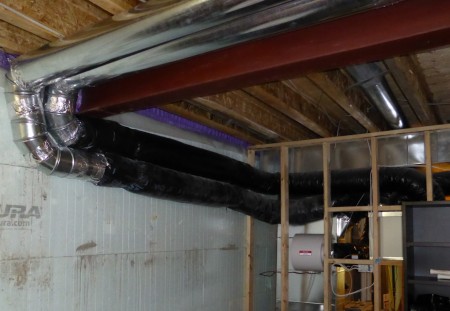
Both fresh air intake and exhaust pipe come off the HRV with about 16′ of insulated flexduct then transition to uninsulated smooth-walled metal pipe.

The bare metal pipes continue and the fresh air intake (top right) transitions to a smaller diameter pipe as it turns into the floor joist cavity. The exhaust pipe (top left along I beam) is also reduced to 4″ as it turns into the floor cavity.

From the reducer (centre metal 4″ duct), the fresh air intake travels the exterior wall with the final 5 feet of pipe that’s insulated.
East of the Humber

BEFORE: Granted, this combined HRV and forced air unit isn’t common, it doesn’t take a rocket scientist to figure out that only one (un-insulated) pipe going to to the HRV is wrong.
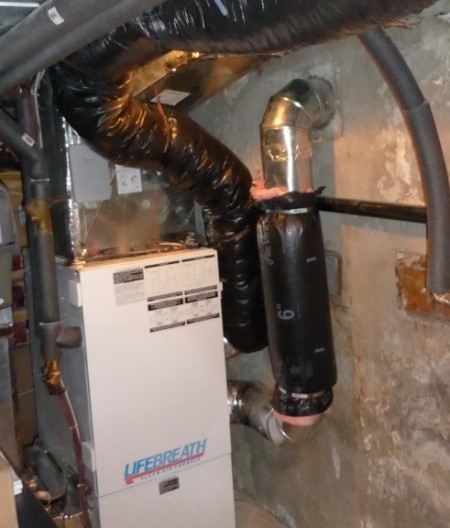
AFTER: Now we have two pipes with a bit of insulation on them; lower – stale air exhaust, upper – fresh air intake.
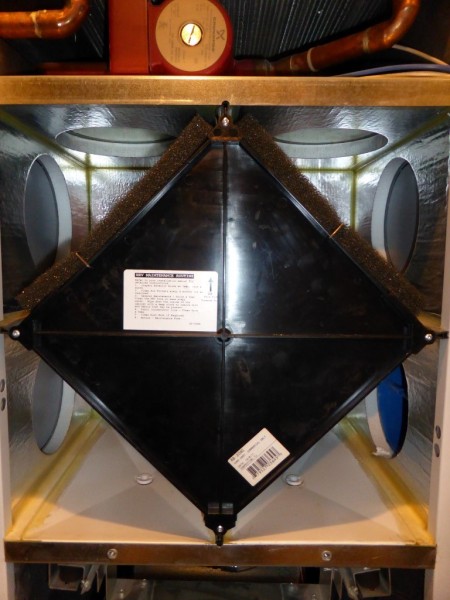
BEFORE: Of the 6 possible circular and two backwall knockouts, only one (blue), is connected as exhaust – but where does it get it’s air from given that neither of the two back knockouts are open either. It’s a dead end.
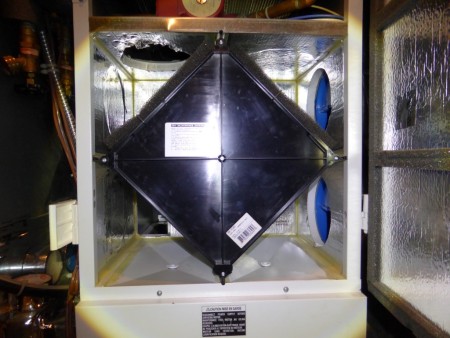
AFTER: Now each quadrant has a knockout open for circulation! Of the 6 possible circular knockouts, now two are open (blue). As in previous picture, one’s connected as exhaust the other an intake. The left quadrants are now open at the top (circular, black) and bottom back wall polygon hole.
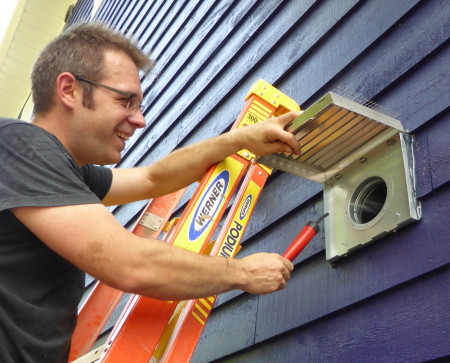
Pinwheel Building Supply’s Hans-Jörn Eich commissioning a ventilation system. Believe it or not, this new construction project had a bag of insulation stuffed into the intake to prevent the birds from getting in. It happens! Hans had to pop the cover and pull out the offending bag to re-establish air flow.
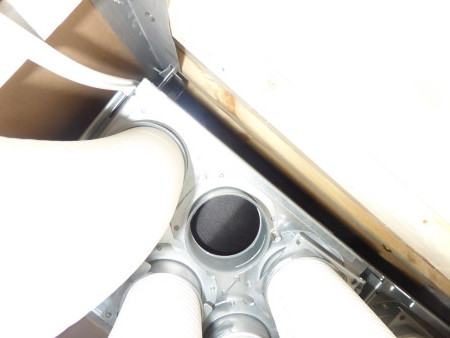
North American trades people don’t understand this plastic duct-work and so what if a $15 plug isn’t installed on the manifold right? It’ll be covered with drywall and who will ever know?
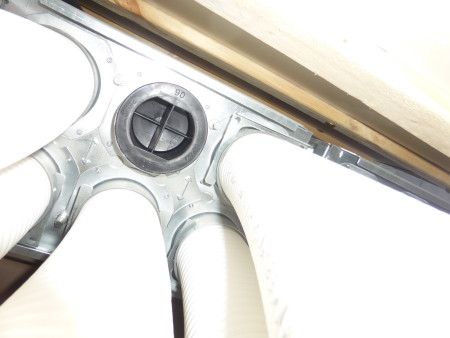
Like the $25,000 bolt on a rocket, this $15 plug installed and $250 of labour to re/re drywall hole in ceiling.

This is new to North Americans and like the missing plug above, we had to cut through the ceiling to see what was going on. Behind the red taped duct, you can just make out a completely disconnected HRV exhaust pipe. On this project, the installer just didn’t support his long duct runs and expected the silicone caulking to hold the pipe up.

NEW in 2017!! The two black flex ducts pipes are connected adjacent to one another on the return plenum of this furnace. Intended as a simplified connection, the sad truth is this system won’t produce much fresh air and is a waste of energy as the air will likely short cycle.

